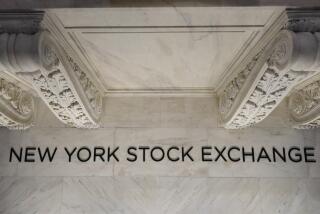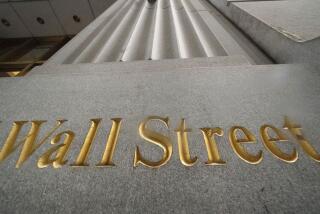Strength of Bonds Continues to Surprise
- Share via
The one “sure bet” on Wall Street at the start of the year was that bonds would bomb.
Wrong.
Bond mutual funds mostly beat stock funds in the third quarter as long-term interest rates fell, boosting the value of existing fixed-rate bonds.
Every bond fund category tracked by Morningstar Inc. posted a positive total return in the third quarter, and every category also was positive in the first nine months of the year.
Total return measures interest earnings plus or minus the change in principal value.
Emerging-market bond funds led all categories, with an average total return of 9.3% in the quarter, as investors snapped up high-yielding debt in Brazil and Russia, among other nations. U.S. corporate junk bond funds also benefited from the hunt for higher yields, posting a total return of 4% on average.
The average fund that owns long-term government bonds rose 3.8% in the quarter and was up 2.9% in the first nine months.
The year-to-date returns aren’t huge, but many bond investors were expecting to lose money this year as the Federal Reserve began to tighten credit and as rising oil prices fanned inflation fears. Both of those factors were expected to push up longer-term interest rates.
They did, for a while. The yield on the benchmark 10-year Treasury note jumped from 3.68% in mid-March to 4.87% by mid-June. But in the third quarter, longer-term rates mostly declined. The T-note yield was below 4% by late September.
What happened? Analysts say investors began buying bonds again, driving yields lower, for many reasons -- including expectations that the economy would continue to slow, a desire for “safer” investments amid continuing terrorism worries, and low official inflation rates despite the surge in oil prices.
But bond yields have turned higher again in the last week. And many Wall Street pros say the direction in 2005 is more likely up than down. That would erode bond funds’ share values.
Michael Darda, economist at investment firm MKM Partners in Greenwich, Conn., said the 10-year T-note, at 4.24% on Thursday, “should be closer to 5% than 4%,” assuming the economy keeps growing and the Fed isn’t finished raising its key short-term rate -- the federal funds rate -- that now is at 1.75%.
“I do think the path [for rates] is gradually higher,” said William Eigen, who helps manage the Fidelity Strategic Income bond fund in Boston.
Some analysts, however, say it’s possible that longer-term yields could move lower for a while if more investors believe the Fed might pause in its credit-tightening campaign because of disappointing economic data.
The drop in yields since June in part reflects “a re-rating of the difficulty of the Fed’s task” in assessing proper interest rate levels, said Steve Wieting, economist at Citigroup Global Markets in New York.
David Rosenberg, economist at Merrill Lynch & Co. in New York, said bond yields could be held down by “the realization that we are going to be in a durable world of a 2% federal funds rate and a durable world of relatively low inflation, low nominal GDP growth and low returns in financial assets.”
If the bond bulls are wrong, and interest rates surge soon, bond fund investors would be hurt. But it’s all relative: Investors still would be earning interest on older bonds, softening the blow of falling principal values.
What’s more, the performance of different types of bonds -- corporate, Treasury, foreign, short-term and long-term -- could vary significantly if rates rise again, Eigen said.
His fund, which had a total return of 4% in the first nine months, “can really go anywhere” in picking bonds, he said. That flexibility becomes more important in an uncertain rate environment, Eigen said.
More to Read
Inside the business of entertainment
The Wide Shot brings you news, analysis and insights on everything from streaming wars to production — and what it all means for the future.
You may occasionally receive promotional content from the Los Angeles Times.










